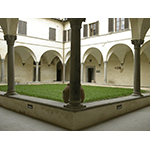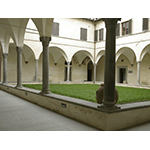Museo Paleontologico dell'Accademia Valdarnese del Poggio [Paleontological Museum of the "Valdarnese del Poggio" Academy]
Established in 1804, the Accademia Valdarnese owes its name and its origin to Poggio Bracciolini, the famous humanist, discoverer of manuscripts and collector of antiquities, who, starting in 1434, surrounded himself with scholars and men of letters with whom he engaged in learned conversation. To this band of humanists he gave the name "Accademia Valdarnina". The permanent seat of the meetings was the Villa di Terranova, owned by Bracciolini.
In 1858 the society, on which was conferred the title "Imperiale e Regia Accademia" by Grand Duke Leopold II of Lorraine in 1848, found permanent quarters at the former Monastery of San Ludovico in Montevarchi, where it is still located today, along with the Museum, the Library and the Archives. At present, the Academy is active in the field of historical and scientific research, evidence of which may be found in its publications.
The first core of the Museo Paleontologico was the collection donated to the Accademia Valdarnese by the Vallombrosan monk Domenico Luigi Mulinari. The collection consisted of a large group of fossil remains of the hippopotamus, elephant, rhinoceros and mastodon found in the Valdarno area, and a group of fossils of petrified wood, seashells and marine animals coming from the territories of San Leo and Montefeltro.
At present, the Museum possesses around 2,000 pieces from the Varldarno area Pliocene and post-Pliocene ages, arranged in typically nineteenth-century style. The collection includes plant fossils and remains of mammals (elephants in particular), birds, reptiles, freshwater fish and shellfish, dating from a period ranging between three million and 100,000 years ago. These findings come almost exclusively from the lacustrine and fluvial-lacustrine territories of the Upper Valdarno hill country. Of particular interest are the examples of Elephans Meridionalis, Hippopotamus Maior, Histrix Etrusca, Canis Etruscus and Equus Stenonis. The collection also includes a group of rock samples from the Valdarno area.
The Library contains nearly 20,000 volumes, a consistent number of them dealing with the subjects of the Museo Paleontologico. The Archive too is especially interesting. Among the manuscripts, it has a treatise on optics from the 18th century, as well as catalogues and records of donations and purchases.
****************************
Texts by Anna Toscano
English translation by Catherine Frost
Last update 18/mar/2008





